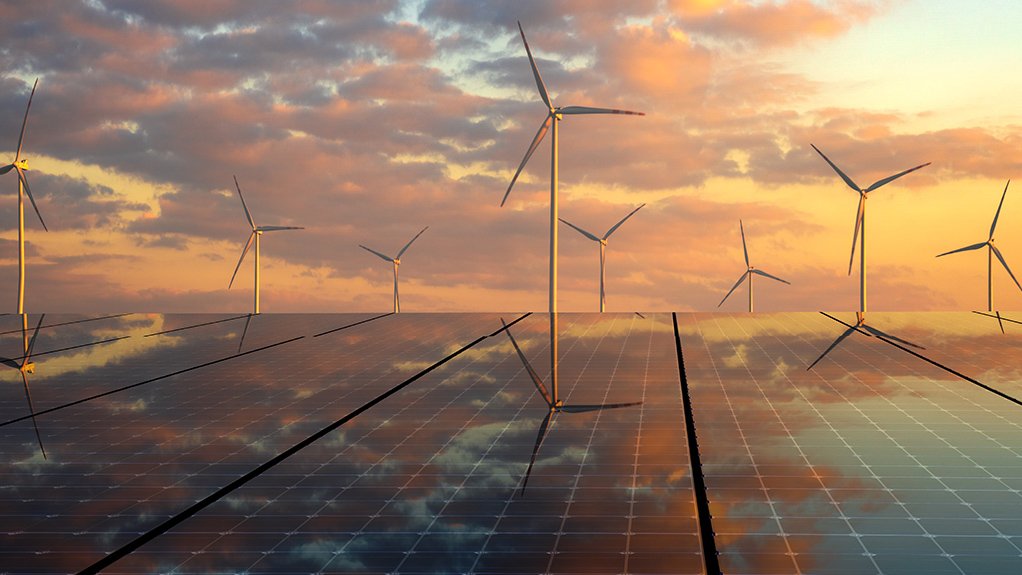Clean energy technology market to rival crude oil market value by 2035
Based on the current policy environment, the global market for clean energy technologies is set to rise from $700-billion in 2023 to more than $2-trillion by 2035, close to the value of the current global crude oil market, a new International Energy Association (IEA) report shows.
The latest edition of the IEA’s ‘Energy Technology Perspectives 2024’ (ETP-2024) report, which was published on October 30, states that trade in clean technologies is also expected to rise sharply. Within a decade from now, it will more than triple to reach $570-billion, more than 50% larger than current natural gas global trade figures.
The ETP-2024 focuses on the outlook for the top six mass-manufactured clean energy technologies: solar PV, wind turbines, electric cars, batteries, electrolysers and heat pumps.
It also looks at key materials such as steel and aluminium and provides a substantive analytical framework for policymakers as they navigate the fast-evolving and complex landscape of clean energy manufacturing and trade.
The report says the rapid uptake of clean energy technologies offers major opportunities for countries looking to manufacture and trade them but also presents challenging decisions for governments, which face tensions and trade-offs based on the industrial and trade policies they opt to pursue.
“The market for clean technologies is set to multiply in value in the coming decade, increasingly catching up with the markets for fossil fuels. As countries seek to define their role in the new energy economy, three vital policy areas – energy, industry and trade – are becoming more and more interlinked.
“While this leaves governments with tough and complicated decisions ahead, this . . . new IEA report provides a strong, data-driven foundation for their decisions,” IEA executive director Fatih Birol explains.
Built on a newly assembled bottom-up dataset and quantitative modelling based on countries’ policies, the ETP-2024 report maps out the current state of clean energy manufacturing and trade and how they are set to evolve.
In doing so, it explores how countries at different stages of development can capture the benefits of the emerging energy economy while seeking to ensure secure and cost-effective clean energy transitions.
“Clean energy transitions present a major economic opportunity, as we have shown, and countries are rightly seeking to capitalise on that. However, governments should strive to develop measures that also foster continued competition, innovation and cost reductions, as well as progress towards their energy and climate goals,” Birol adds.
The IEA says the growth of the global clean technology market has been accompanied by a record wave of investment in the manufacturing of clean technologies, as countries look to bolster their energy security, maintain their economic edge and reduce emissions.
Most of this spending is concentrated in the countries and regions that have already established a clear foothold in the sector and are looking to build on their positions. These include China, the EU and the US, with India becoming increasingly active.
However, despite the strong impact of the Inflation Reduction Act and Bipartisan Infrastructure Law in the US, as well as the EU’s Net-Zero Industry Act and India’s Production Linked Incentive Scheme, China is set to remain the world’s manufacturing powerhouse for the foreseeable future.
Under current policy settings, China’s clean technology exports are on track to exceed $340-billion in 2035, which is nearly equivalent to the projected oil export revenue this year of Saudi Arabia and the United Arab Emirates combined.
Currently, countries in Southeast Asia, Latin America and Africa account for less than 5% of the value generated from producing clean technologies. However, ETP-2024 emphasises that the door of the new clean energy economy remains open to countries at different stages of development.
The report identifies key opportunities for emerging and developing economies based on a country-by-country assessment of more than 60 indicators, such as the business environment, infrastructure for energy and transport, resource availability and domestic market size.
The report finds that, beyond the mining and processing of critical minerals, emerging and developing economies could draw on their competitive advantages to move up the value chain.
For example, Southeast Asia could become one of the cheapest places to produce polysilicon and wafers for solar panels within the next ten years, while Latin America, particularly Brazil, has the potential to scale up its wind turbine manufacturing for export to other markets in the Americas.
North Africa has the ingredients to become an electric vehicle manufacturing hub within the next decade, while various countries in sub-Saharan Africa could produce iron with low-emissions hydrogen.
“Growth in the manufacturing and trade of clean energy technologies should be for the benefit of many economies, not just a few. This report shows that countries in Southeast Asia, Latin America, Africa and beyond and have strong potential to play important roles in the new energy economy.
“And it finds that, with sound strategic partnerships, increased investment and greater efforts to bring down high financing costs, they can achieve this potential,” Birol says.
The report also digs into the important global implications as trade in clean energy technology expands. For one, the shift from importing fossil fuels to importing clean technologies could increase the resilience of energy supplies.
While fossil fuel supplies need to be replenished as soon as they are consumed, importing clean technologies results in a durable stock of energy equipment, the IEA says.
This results in greater efficiency, since a single journey by a large container ship filled with solar PV modules can provide the means to generate the same amount of electricity as the natural gas from more than 50 large liquefied natural gas tankers or the coal from more than 100 large bulk ships.
However, the report points out that there are also new energy security dimensions to consider. Currently, about half of all maritime trade in clean energy technologies passes through the Strait of Malacca, which connects the Indian and Pacific Oceans.
While the implications for energy security differ, the IEA notes that this is significantly more than the about 20% of fossil fuel trade that passes through the Strait of Hormuz.
Article Enquiry
Email Article
Save Article
Feedback
To advertise email advertising@creamermedia.co.za or click here
Comments
Press Office
Announcements
What's On
Subscribe to improve your user experience...
Option 1 (equivalent of R125 a month):
Receive a weekly copy of Creamer Media's Engineering News & Mining Weekly magazine
(print copy for those in South Africa and e-magazine for those outside of South Africa)
Receive daily email newsletters
Access to full search results
Access archive of magazine back copies
Access to Projects in Progress
Access to ONE Research Report of your choice in PDF format
Option 2 (equivalent of R375 a month):
All benefits from Option 1
PLUS
Access to Creamer Media's Research Channel Africa for ALL Research Reports, in PDF format, on various industrial and mining sectors
including Electricity; Water; Energy Transition; Hydrogen; Roads, Rail and Ports; Coal; Gold; Platinum; Battery Metals; etc.
Already a subscriber?
Forgotten your password?
Receive weekly copy of Creamer Media's Engineering News & Mining Weekly magazine (print copy for those in South Africa and e-magazine for those outside of South Africa)
➕
Recieve daily email newsletters
➕
Access to full search results
➕
Access archive of magazine back copies
➕
Access to Projects in Progress
➕
Access to ONE Research Report of your choice in PDF format
RESEARCH CHANNEL AFRICA
R4500 (equivalent of R375 a month)
SUBSCRIBEAll benefits from Option 1
➕
Access to Creamer Media's Research Channel Africa for ALL Research Reports on various industrial and mining sectors, in PDF format, including on:
Electricity
➕
Water
➕
Energy Transition
➕
Hydrogen
➕
Roads, Rail and Ports
➕
Coal
➕
Gold
➕
Platinum
➕
Battery Metals
➕
etc.
Receive all benefits from Option 1 or Option 2 delivered to numerous people at your company
➕
Multiple User names and Passwords for simultaneous log-ins
➕
Intranet integration access to all in your organisation



















